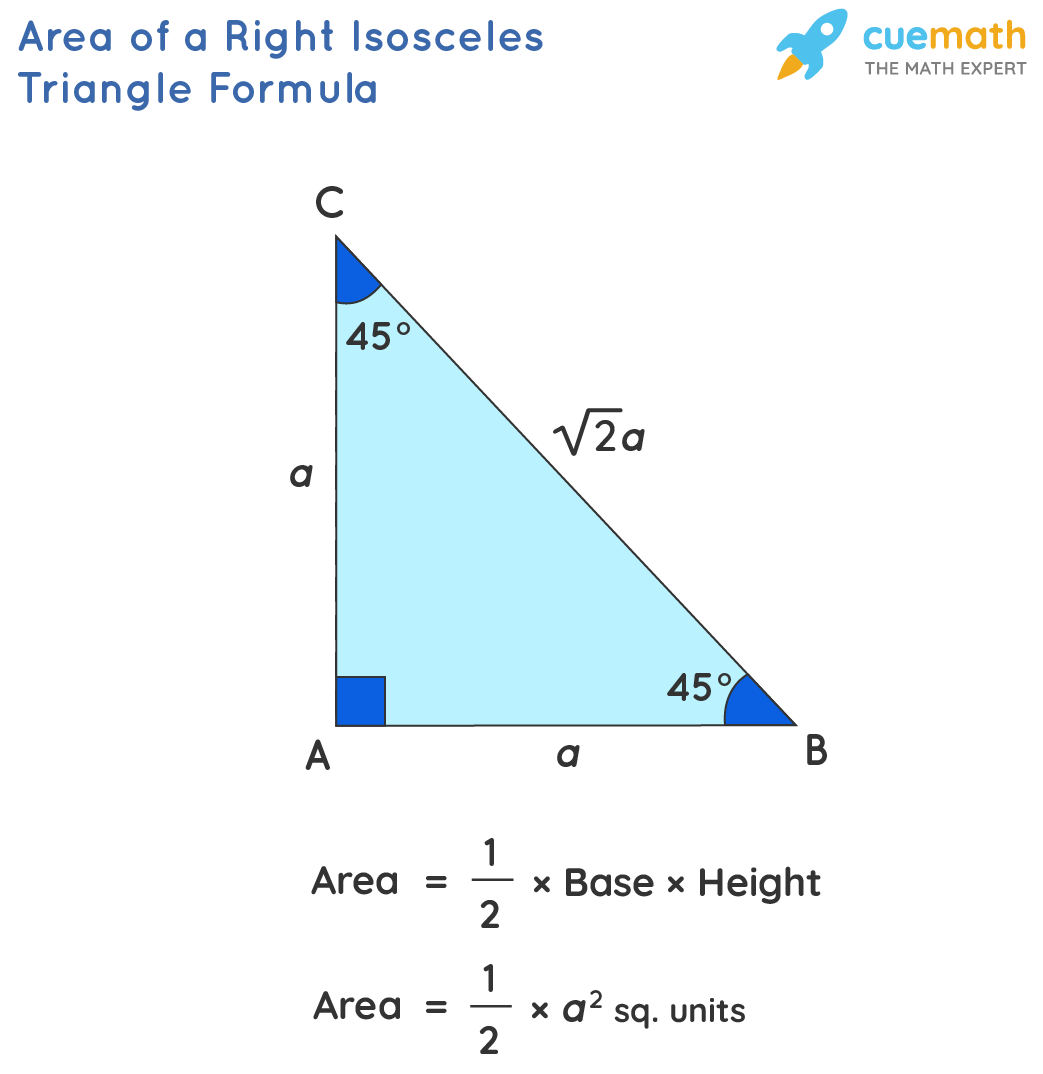
The area of an isosceles triangle is the amount of space enclosed between the sides of the triangle. Besides the general area of the isosceles triangle formula, which is equal to half the product of the base and height of the triangle, different formulas are used to calculate the area of triangles, depending upon their classification based on sides. These different types based on sides are given below:
Let us understand the area of the isosceles triangle in detail in the following section.
| 1. | What is Area of an Isosceles Triangle? |
| 2. | Area of Isosceles Triangle Formulas |
| 3. | Area of Isosceles Triangle Using Sides |
| 4. | Isosceles Triangle Area Using Heron’s Formula |
| 5. | Isosceles Triangle Area Using Trigonometry(SAS and ASA) |
| 6. | Area of Isosceles Right Triangle |
| 7. | FAQs on Area of Isosceles Triangle |
The area of an isosceles triangle is the total space or region covered between the sides of an isosceles triangle in two-dimensional space. An isosceles triangle is defined as a triangle having two sides equal, which also means two equal angles. Here are some properties of an Isosceles triangle that distinguish it from other types of triangles:
The area of an isosceles triangle is expressed in square units. Therefore, some units that can be used to represent the area of an isosceles triangle are m 2 , cm 2 , in 2 , yd 2 , etc.
The area of an isosceles triangle refers to the total space covered by the shape in 2-D. The area of an isosceles triangle can be calculated in many ways based on the known elements of the isosceles triangle. The general basic formula that can be used to calculate the area of an isosceles triangle using height is given as, (1/2) × Base × Height

The following table summarizes different formulas that can be used to calculate the area of an isosceles triangle, for a different set of known parameters.
If the length of the equal sides and the base of an isosceles triangle are known, then the height or altitude of the triangle can be calculated. The formula to calculate the area of an Isosceles triangle using sides is given as,
Area of isosceles triangle using only sides = ½[√(a 2 - b 2 /4) × b]

Derivation:
From the above figure, we know:
BD = DC = ½ BC = ½ b (perpendicular from the vertex angle bisects the base)
AB = AC = a (equal sides of an isosceles triangle)
Applying Pythagoras' theorem for ΔABD, we get:
a 2 = (b/2) 2 + (AD) 2
AD = √(a 2 − b 2 /4)
The altitude of an isosceles triangle = √(a 2 − b 2 /4)
Also, we know the general area of the triangle formula is given as:
Area = ½ × b × h
Substituting value for height:
Area of isosceles triangle using only sides = ½[√(a 2 − b 2 /4) × b]
The area of an isosceles triangle formula can be easily derived using Heron’s formula as explained in the following steps. Heron's formula is used to find the area of a triangle when the measurements of its 3 sides are given.
Derivation:
The Heron's formula to find the area, A of a triangle whose sides are a,b, and c is:
We know that the perimeter of a triangle with sides a, b, and c is a + b + c. Here, s is half of the perimeter of the triangle, and hence, it is called semi-perimeter.
Thus, the semi-perimeter is:
Now, for an isosceles triangle,
or, Area = √[s (s−a) 2 (s−b)]
Substituting the value for “s”
⇒ Area = (a + b/2 − a) × √[(a + b/2) × ((a + b/2) − b)]
⇒ Area = b/2 × √[(a + b/2) × (a − b/2)]
Area of isosceles triangle = b/2 × √(a 2 − b 2 /4) square units
The formula to find area of an isosceles triangle using length of 2 sides and angle between them or using 2 angles and length between them can be calculated using basic trigonometry concepts.
Using 2 sides and angle between them:
Area = ½ × b × a × sin(α) square units
Using 2 angles and length between them:
Area = [a 2 × sin(β/2) × sin(α)] square units
A right isosceles triangle is defined as the isosceles triangle which has one angle equal to 90°. The Formula to calculate the area for an isosceles right triangle can be expressed as,
where a is the length of equal sides.
Derivation:
Let the equal sides of the right isosceles triangle be denoted as "a", as shown in the figure below:

The length of the hypotenuse, BC can be calculated using Pythagoras' Theorem,
Area = ½ × base × height
Area = ½ × a × a = a 2 /2 square units
Example 1: Find the area of an isosceles triangle given the length of the base is 10 cm and height is 17 cm? Solution: Base of the triangle (b) = 10 cm Height of the triangle (h) = 17 cm Area of Isosceles Triangle = (1/2) × b × h = (1/2) × 10 × 17 = 5 × 17 = 85 cm 2 Answer: The area of the given isosceles triangle is 85 cm 2 .
Example 2: Find the length of the base of an isosceles triangle whose area is 243 cm 2 , and the altitude of the triangle is 9 cm. Solution: Area of the triangle, A = 243 cm 2 Height of the triangle (h) = 9 cm The base of the triangle = b =? Area of Isosceles Triangle = (1/2) × b × h 243 = (1/2) × b × 9 243 = (b × 9)/2 b = (243 × 2)/9 b = 54 cm Answer: The altitude of the given isosceles triangle is 54 cm.
Example 3: Find the length of the equal sides of an isosceles triangle whose base is 24 cm and the area is 60 cm 2 . Solution: We know that, The base of the isosceles triangle = 24 cm Area of the isosceles triangle = 60 cm 2 Area of isosceles triangle = b/2 × √(a 2 − b 2 /4) Therefore, 60 = (24/2)√(a 2 − 24 2 /4) 60 = 12√(a 2 − 144) 5 = √(a 2 −144) Squaring both sides, we get, 25 = a 2 −144 a 2 = 169 ⇒a = 13 cm Answer: The length of the equal sides of the given isosceles triangle is 13 cm.
Show Solution >
Math will no longer be a tough subject, especially when you understand the concepts through visualizations.